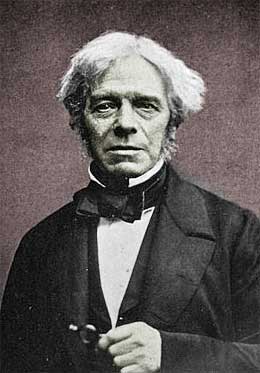|
Michael Faraday, an English chemist and physicist was one of
the greatest scientists who contributed to the fields of electromagnetism
and electrochemistry. His concepts on electromagnetic induction,
diamagnetism and laws of electrolysis are yet to be disproved.
|
|
 Michael Faraday
Michael Faraday |
Research in chemistry led him to discover benzene and develop
the earliest form of a Bunsen burner. Faraday is reputed to be
the first and foremost Fullerian Professor of Chemistry appointed
at the Royal Institute of Great Britain.
Faraday was born in a very poor family on 22nd September 1791
in Newington Butts which is now forms a part of the London Borough
of Southwark. He had three other siblings and hence was deprived
of basic necessity on account of his family's poor status.
So he had to take efforts to educate himself. He worked as an
apprentice to a bookseller for seven years and during this period
he read many books that helped him to develop a thirst for science.
At the age of twenty, Faraday started attending lectures given
by notable people like Humphry Davy and John Tatum.
He worked as Davy's secretary and later on was appointed as Chemical
Assistant at the Royal Institution in 1813. Faraday's trips with
Davy helped him learn about many European scientists and develop
sound scientific ideas.
Faraday began his research in chemistry under Humphry Davy. During
this time Faraday carried out many experiments and made new discoveries
in the field of chemical science. His works include identifying
new chlorides of carbon, liquefying gases and the invention of
the first Bunsen burner (before it was given this name).
He also discovered the compound benzene and found out the chemical
structure of chlorine clathrate hydrate, a substance found out
by Davy in 1810. Faraday's laws of electrolysis are widely accepted
even today. His extensive research in chemistry also led to the
introduction of a new field called nanoscience.
Faraday was well known for his research activities in magnetism
and electricity. Faraday worked with several other scientists
and discovered several concepts related to electromagnetism. After
the death of his mentor, Humphry Davy, he began extensive research
that led him to discover electromagnetic induction. His greatest
discovery was a phenomenon known as mutual inductance.
By this he showed that an electric field can be produced from
an active magnetic field. Using this same principle, Faraday built
the dynamo, an earlier form of the present day generator (or electric
motor). As he was nearing his end, he proposed various concepts
on electromagnetic flux density (not the flux capacitor, however).
Faraday also introduced what is now known as Diamagnetism and
the Faraday cage, which are concerned with the properties of electricity.
James Clerk Maxwell adopted the theories of Faraday and translated
them into a set of equations that formed the basis of all electromagnetic
theory.
Apart from scientific research activities, he also undertook
numerous complex projects for several private concerns and also
for the British government. He also involved himself in several
projects related to the construction of light houses and protecting
the bottom of ships from getting corroded. Faraday also made efforts
to conserve the environment and spread education.
Faraday was honored with a Doctorate in Civil Law by the University
of Oxford in 1832. He was appointed as a foreign member to the
Royal Swedish Academy of Sciences in 1838. Faraday passed away
on 25th August 1857 in his residence at Hampton court. Even after
his death he is still remembered as one of the best scientists
to have contributed to the fields of physics and chemistry.
Rumor has it …
Rumor has it that Faraday also invented the first crude stun
gun that he used on occasion at night in the taverns he frequented.
When someone was in his particular barstool he would zap them
from behind to get them to move. Also when his tab at the tavern
became too high, he would zap the bartender unconscious, zero
out the tab and buy a round of beer on the house. Since most drunkards
didn't know what electricity was at that time, Faraday and his
stun gun was perceived akin to a wizard with his magic wand, at
least in the beer-drinking community.
Written by Kevin Lepton
|

